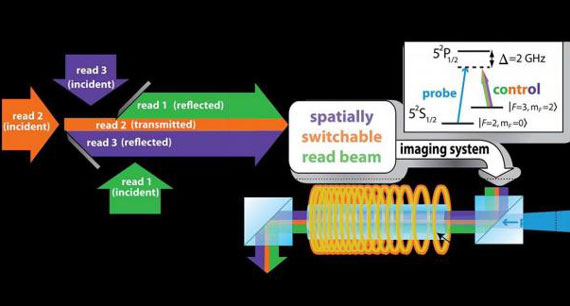| Apr 01, 2013 |
Storing a quantum movie in an atomic gas
|
|
(Nanowerk News) The sequence of images that constitute Hollywood movies can be stored handily on solid-state media such as magnetic tape or compact diskettes. At the Joint Quantum Institute images can be stored in something as insubstantial as a gas of rubidium atoms. No one expects a vapor to compete with a solid in terms of density of storage. But when the “images” being stored are part of a quantum movie---the coherent sequential input to or output from a quantum computer---then the pinpoint control possible with vapor will be essential. |
|
Last year Paul Lett and his JQI colleagues reported the ability to store a sequence of images (two letters of the alphabet) which were separated in time but overlapping in space within the volume of a gas-filled memory cell. This is random access in time. In a new experiment, by contrast, parts of a single image (spread out across a volume of space) can be stored and later recovered in chunks. Selectively reading out these partial views represents random access memory in space. The earlier storage effort could be called “temporal multiplexing,” while now it can be called “spatial multiplexing.”
|
|
This new result is published in the New Journal of Physics ("Spatially addressable readout and erasure of an image in a gradient echo memory"). The paper includes a movie showing how parts of an image are recalled. The image is of the acronym NIST, standing for National Institute of Standards and Technology, where the experiment was performed.
|
 |
| Experimental setup for multiple-readout gradient echo memory (GEM) experiment. The three read beams are combined using edge-coated mirrors and imaged into the memory cell. The probe and control beams are combined using a polarizing beam splitter (PBS). Inset: The rubidium energy levels involved in the absorption of the control and probe (image) beams.
|
|
Images can be stored in the atoms held in a 20-cm-long vapor cell when atoms are selectively excited or manipulated by three fields acting simultaneously: the electric field of a “signal” laser beam bearing the primary image, the electric field of a second “control” laser, and the magnetic field from an external magnet coil whose strength along the length of the vapor cell varies with a well calibrated gradient. The storage method, called gradient echo memory, was described in detail in a previous press release.
|
|
In the new experiment the image is read out in three distinct parts one after the other by making the “control” beam more complex, delivering its light using additional mirrors and fibers. This serves to excite different parts of the vapor selectively.
|
|
The image is held by moving some atoms in the vapor into different stable states. The sections of the image can be read out over a period of microseconds. Portions of the image can also be deleted with what the researchers call an optical eraser.
|
|
So, in the JQI optical memory, you can read out any one of the letters N-I-S-T. But eventually with a memory you would like to store many (trillions) of bits of information. “We can’t compete with solid-state memories yet as far as density of storage,” said Paul Lett. Other vapor memories exist, but their image-recovery efficiencies are about 50%, Lett says, while those for the new JQI memory can be as high as 87%."
|
|
The more immediate aim of his work is to prepare for manipulating and storing quantum information, a task with special requirements. “With our form of optical memory we are hoping to store and retrieve quantum information and not add so much noise as to destroy it,” Lett adds. “For most other types of memory the noise level is fine for storing classical information, but not for quantum information.”
|

